小学节日主题英语手抄报
- 格式:doc
- 大小:1.27 MB
- 文档页数:1
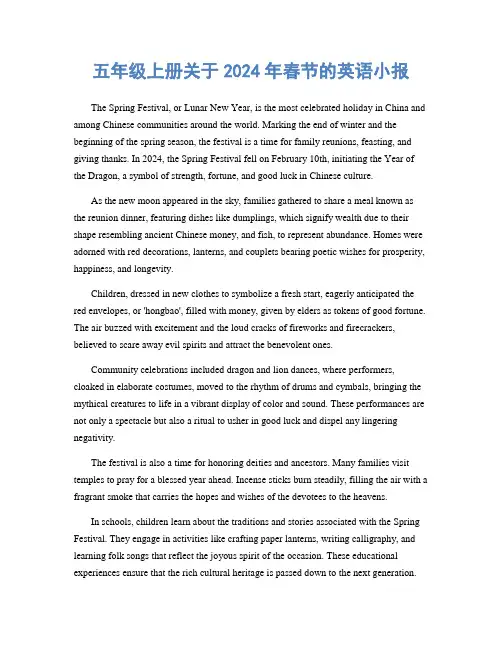
五年级上册关于2024年春节的英语小报The Spring Festival, or Lunar New Year, is the most celebrated holiday in China and among Chinese communities around the world. Marking the end of winter and the beginning of the spring season, the festival is a time for family reunions, feasting, and giving thanks. In 2024, the Spring Festival fell on February 10th, initiating the Year of the Dragon, a symbol of strength, fortune, and good luck in Chinese culture.As the new moon appeared in the sky, families gathered to share a meal known as the reunion dinner, featuring dishes like dumplings, which signify wealth due to their shape resembling ancient Chinese money, and fish, to represent abundance. Homes were adorned with red decorations, lanterns, and couplets bearing poetic wishes for prosperity, happiness, and longevity.Children, dressed in new clothes to symbolize a fresh start, eagerly anticipated the red envelopes, or 'hongbao', filled with money, given by elders as tokens of good fortune. The air buzzed with excitement and the loud cracks of fireworks and firecrackers, believed to scare away evil spirits and attract the benevolent ones.Community celebrations included dragon and lion dances, where performers, cloaked in elaborate costumes, moved to the rhythm of drums and cymbals, bringing the mythical creatures to life in a vibrant display of color and sound. These performances are not only a spectacle but also a ritual to usher in good luck and dispel any lingering negativity.The festival is also a time for honoring deities and ancestors. Many families visit temples to pray for a blessed year ahead. Incense sticks burn steadily, filling the air with a fragrant smoke that carries the hopes and wishes of the devotees to the heavens.In schools, children learn about the traditions and stories associated with the Spring Festival. They engage in activities like crafting paper lanterns, writing calligraphy, and learning folk songs that reflect the joyous spirit of the occasion. These educational experiences ensure that the rich cultural heritage is passed down to the next generation.The Spring Festival concludes with the Lantern Festival, which takes place on the fifteenth day of the first lunar month. People stroll through streets lined with lanterns of all sizes and shapes, solving riddles written on them, a tradition that dates back over a thousand years. The night sky is illuminated by the glow of lanterns, symbolizing the letting go of the past and the welcoming of a brighter future.The Spring Festival of 2024 was a testament to the enduring nature of these traditions, even as the world changes around us. It's a time when the past and present merge, creating a bridge to the future, grounded in the values of family, gratitude, and hope. As the festivities draw to a close, the spirit of the Spring Festival lingers, reminding us of the continuous cycle of seasons and the promise of renewal that each new year brings.。
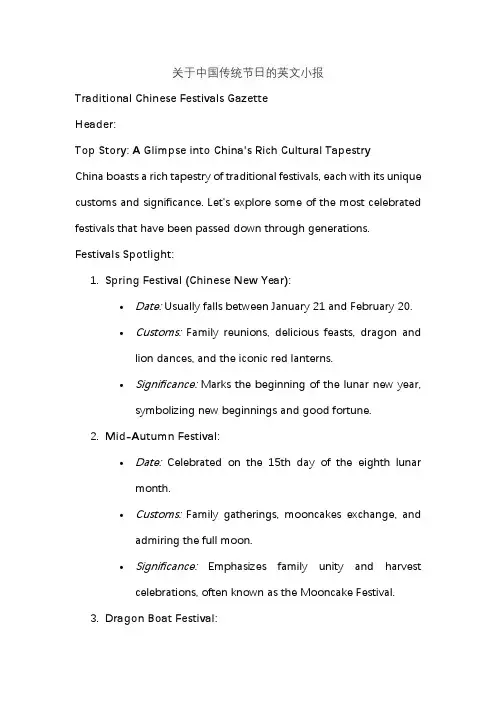
关于中国传统节日的英文小报Traditional Chinese Festivals GazetteHeader:Top Story:A Glimpse into China's Rich Cultural TapestryChina boasts a rich tapestry of traditional festivals, each with its unique customs and significance. Let's explore some of the most celebrated festivals that have been passed down through generations. Festivals Spotlight:1.Spring Festival (Chinese New Year):•Date: Usually falls between January 21 and February 20.•Customs:Family reunions, delicious feasts, dragon and lion dances, and the iconic red lanterns.•Significance: Marks the beginning of the lunar new year, symbolizing new beginnings and good fortune.2.Mid-Autumn Festival:•Date:Celebrated on the 15th day of the eighth lunar month.•Customs:Family gatherings, mooncakes exchange, and admiring the full moon.•Significance:Emphasizes family unity and harvest celebrations, often known as the Mooncake Festival.3.Dragon Boat Festival:•Date: Falls on the fifth day of the fifth lunar month.•Customs:Dragon boat races, eating zongzi (rice dumplings wrapped in bamboo leaves), and hanging uppouches of herbs.•Significance:Commemorates the poet Qu Yuan, emphasizing loyalty and warding off evil spirits.4.Double Ninth Festival (Chongyang Festival):•Date:Celebrated on the ninth day of the ninth lunar month.•Customs:Climbing mountains, appreciating chrysanthemums, and drinking chrysanthemum wine.•Significance: A day to pay respects to seniors and enjoy the autumn scenery.Culinary Delights:Indulge in Festive Flavors1.Mooncakes:•Enjoy these delicious pastries filled with sweet bean paste or lotus seed paste, often exchanged during the Mid-Autumn Festival.2.Zongzi:•Savor the flavors of sticky rice, wrapped in bamboo leaves and filled with various ingredients, traditionally eatenduring the Dragon Boat Festival.Festivals in Modern Times:Explore how traditional festivals are celebrated in contemporary China.Did You Know?:Interesting Facts about Chinese Festivals1.The Spring Festival is known as the largest human migrationglobally, as millions travel to be with their families.2.The Mid-Autumn Festival has a connection to ancient moon-worshipping ceremonies.3.Dragon Boat Festival's origin is linked to the legend of Qu Yuan,a patriotic poet.Bottom Section:Immerse yourself in the cultural vibrancy of traditional Chinese festivals. Whether it's the joyous reunions of Spring Festival or the colorful dragon boat races, these celebrations embody the essence of Chinese heritage.Discover the beauty, traditions, and flavors that make Chinese festivals a unique and cherished experience.Happy Celebrations!(Gazette Editor: Your Name)PS: Enhance the visual appeal with images and graphics to make the information more engaging!。
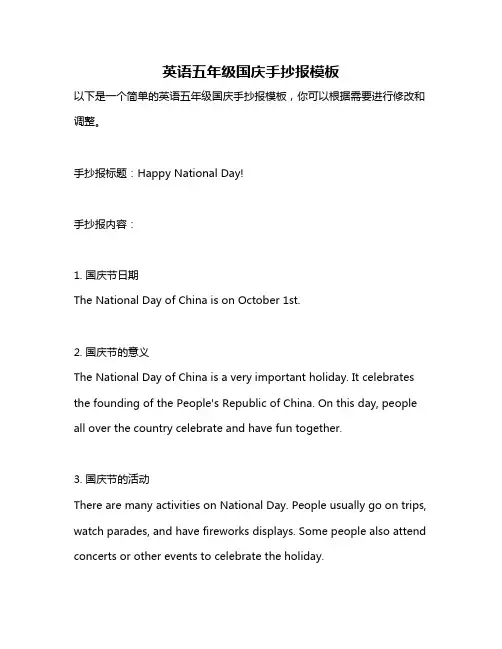
英语五年级国庆手抄报模板
以下是一个简单的英语五年级国庆手抄报模板,你可以根据需要进行修改和调整。
手抄报标题:Happy National Day!
手抄报内容:
1. 国庆节日期
The National Day of China is on October 1st.
2. 国庆节的意义
The National Day of China is a very important holiday. It celebrates the founding of the People's Republic of China. On this day, people all over the country celebrate and have fun together.
3. 国庆节的活动
There are many activities on National Day. People usually go on trips, watch parades, and have fireworks displays. Some people also attend concerts or other events to celebrate the holiday.
4. 祝福语
Happy National Day! I hope you have a great holiday!
希望这个手抄报模板能够帮助你完成自己的作品。
祝你在国庆节期间玩得愉快!。

小学节日主题中英语手抄报内容在小学阶段,制作节日主题的英语手抄报是一项既有趣又能提升英语学习效果的活动。
手抄报不仅可以锻炼孩子们的动手能力,还能让他们更深入地了解不同节日的文化内涵,同时提高英语的运用能力。
那么,小学节日主题的英语手抄报可以包含哪些内容呢?首先,我们来谈谈春节(Spring Festival)。
在手抄报中,可以用简单的英语介绍春节的时间,比如“Spring Festival usually comes in January or February” 还可以描述春节的传统习俗,像“People clean their houses before the festival to sweep away bad luck”(人们在节前打扫房屋,扫除厄运。
)“They have a big family dinner on New Year's Eve and watch the Spring Festival Gala”(他们在除夕夜吃丰盛的年夜饭,看春节联欢晚会。
)对于孩子们喜欢的红包,可以这样写“Children can get lucky money in red envelopes It brings them good luck”(孩子们能得到装在红包里的压岁钱,这会给他们带来好运。
)再配上一些精美的春节元素图片,如春联、鞭炮、福字等,会让手抄报更加生动。
接下来是中秋节(MidAutumn Festival)。
可以写“MidAutumn Festival is on the fifteenth day of the eighth lunar month” (中秋节在农历八月十五。
)“People eat mooncakes and enjoy the full moon on that day” (人们在那天吃月饼、赏月。
)然后画一些可爱的玉兔和圆圆的月亮,让手抄报充满节日氛围。
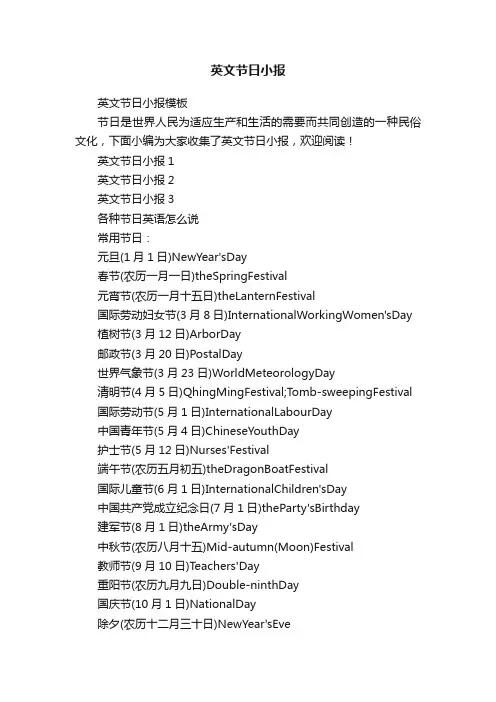
英文节日小报英文节日小报模板节日是世界人民为适应生产和生活的需要而共同创造的一种民俗文化,下面小编为大家收集了英文节日小报,欢迎阅读!英文节日小报1英文节日小报2英文节日小报3各种节日英语怎么说常用节日:元旦(1月1日)NewYear'sDay春节(农历一月一日)theSpringFestival元宵节(农历一月十五日)theLanternFestival国际劳动妇女节(3月8日)InternationalWorkingWomen'sDay 植树节(3月12日)ArborDay邮政节(3月20日)PostalDay世界气象节(3月23日)WorldMeteorologyDay清明节(4月5日)QhingMingFestival;Tomb-sweepingFestival 国际劳动节(5月1日)InternationalLabourDay中国青年节(5月4日)ChineseYouthDay护士节(5月12日)Nurses'Festival端午节(农历五月初五)theDragonBoatFestival国际儿童节(6月1日)InternationalChildren'sDay中国共产党成立纪念日(7月1日)theParty'sBirthday建军节(8月1日)theArmy'sDay中秋节(农历八月十五)Mid-autumn(Moon)Festival教师节(9月10日)Teachers'Day重阳节(农历九月九日)Double-ninthDay国庆节(10月1日)NationalDay除夕(农历十二月三十日)NewYear'sEve阳历节日1月1日元旦(New Year's Day)2月2日世界湿地日(World Wetlands Day)2月14日情人节(Valentine's Day)3月3日全国爱耳日3月5日青年志愿者服务日3月8日国际妇女节(International Women' Day)3月9日保护母亲河日3月12日中国植树节(China Arbor Day)3月14日白色情人节(White Day)3月14日国际警察日(International Policemen' Day)3月15日世界消费者权益日(World Consumer Right Day)3月21日世界森林日(World Forest Day)3月21日世界睡眠日(World Sleep Day)3月22日世界水日(World Water Day)3月23日世界气象日(World Meteorological Day)3月24日世界防治结核病日(World Tuberculosis Day)4月1日愚人节(April Fools' Day)4月5日清明节(Tomb-sweeping Day)4月7日世界卫生日(World Health Day)4月22日世界地球日(World Earth Day)4月26日世界知识产权日(World Intellectual Property Day) 5月1日国际劳动节(International Labour Day)5月3日世界哮喘日(World Asthma Day)5月4日中国青年节(Chinese Youth Day)5月8日世界红十字日(World Red-Cross Day)5月12日国际护士节(International Nurse Day)5月15日国际家庭日(International Family Day)5月17日世界电信日(World Telecommunications Day)5月20日全国学生营养日5月23日国际牛奶日(International Milk Day)5月31日世界无烟日(World No-Smoking Day)6月1日国际儿童节(International Children's Day)6月5日世界环境日(International Environment Day)6月6日全国爱眼日6月17日世界防治荒漠化和干旱日(World Day to combat desertification)6月23日国际奥林匹克日(International Olympic Day)6月25日全国土地日6月26日国际禁毒日(International Day Against Drug Abuse and Illicit Trafficking)7月1日中国共产党诞生日(Anniversary of the Founding of the Chinese Communist Party)7月1日国际建筑日(International Architecture Day)7月7日中国人民抗日战争纪念日7月11日世界人口日(World Population Day)8月1日中国人民解放军建军节(Army Day)8月12日国际青年节(International Youth Day)9月8日国际扫盲日(International Anti-illiteracy Day)9月10日中国教师节(Teacher's Day)9月16日中国脑健康日9月16日国际臭氧层保护日(International Day for the Preservation of the Ozone Layer)9月20日全国爱牙日9月21日世界停火日(World Cease-fire Day)9月27日世界旅游日(World Tourism Day)10月1日中华人民共和国国庆节(National Day)10月1日国际音乐日(International Music Day)10月1日国际老年人日(International Day of Older Persons)10月4日世界动物日(World Animal Day)10月5日世界教师日(World Teachers' Day)(联合国教科文组织确立)10月8日全国高血压日10月9日世界邮政日(World Post Day)10月10日世界精神卫生日(World Mental Health Day)10月14日世界标准日(World Standards Day)10月15日国际盲人节(International Day of the Blind)10月15日世界农村妇女日(World Rural Women's Day)10月16日世界粮食日(World Food Day)10月17日国际消除贫困日(International Day for the Eradication of Poverty)10月24日联合国日(United Nations Day)10月24日世界发展新闻日(World Development Information Day)10月28日中国男性健康日10月29日国际生物多样性日(International Biopersity Day)10月31日万圣节(Halloween)11月8日中国记者节11月9日消防宣传日11月14日世界糖尿病日(World Diabetes Day)11月17日国际大学生节11月25日国际消除对妇女的暴力日(International Day For the elimination of Violence against Women)12月1日世界爱滋病日(World AIDS Day)12月3日世界残疾人日(World Disabled Day)12月4日全国法制宣传日12月9日世界足球日(World Football Day)12月25日圣诞节(Christmas Day)12月29日国际生物多样性日(International Biological Diversity Day)1月最后一个星期日国际麻风节3月最后一个完整周的`星期一中小学生安全教育日春分月圆后的第一个星期日复活节(Easter Monday)(有可能是3月22-4月25日间的任一天)5月第二个星期日母亲节(Mother's Day)5月第三个星期日全国助残日6月第三个星期日父亲节(Father's Day)9月第三个星期二国际和平日(International Peace Day)9月第三个星期六全国国防教育日9月第四个星期日国际聋人节(International Day of the Deaf)10月的第一个星期一世界住房日(World Habitat Day)10月的第二个星斯一加拿大感恩节(Thanksgiving Day)10月第二个星期三国际减轻自然灾害日(International Day for Natural Disaster Reduction)10月第二个星期四世界爱眼日(World Sight Day)11月最后一个星期四美国感恩节(Thanksgiving Day)。
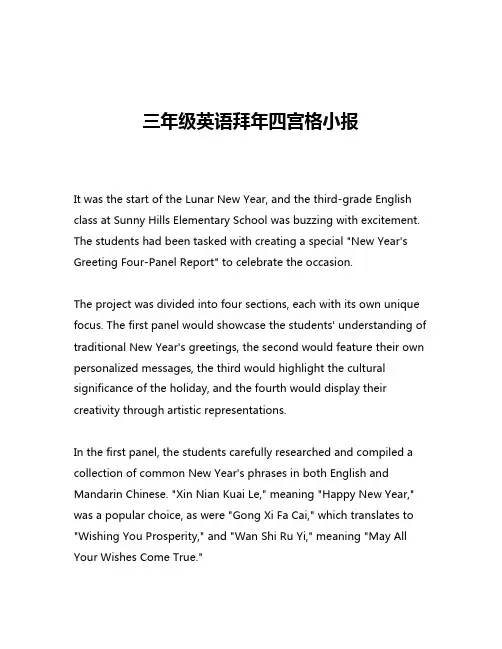
三年级英语拜年四宫格小报It was the start of the Lunar New Year, and the third-grade English class at Sunny Hills Elementary School was buzzing with excitement. The students had been tasked with creating a special "New Year's Greeting Four-Panel Report" to celebrate the occasion.The project was divided into four sections, each with its own unique focus. The first panel would showcase the students' understanding of traditional New Year's greetings, the second would feature their own personalized messages, the third would highlight the cultural significance of the holiday, and the fourth would display their creativity through artistic representations.In the first panel, the students carefully researched and compiled a collection of common New Year's phrases in both English and Mandarin Chinese. "Xin Nian Kuai Le," meaning "Happy New Year," was a popular choice, as were "Gong Xi Fa Cai," which translates to "Wishing You Prosperity," and "Wan Shi Ru Yi," meaning "May All Your Wishes Come True."The students took great pride in sharing these greetings, practicing their pronunciation and even teaching their classmates the proper way to deliver them. They recognized the importance of preserving cultural traditions and were eager to share their newfound knowledge with their families and friends.The second panel was where the students truly shone. They were given the opportunity to craft their own personalized New Year's messages, drawing inspiration from their experiences and aspirations. Some wrote heartfelt wishes for good health and happiness, while others expressed gratitude for their loved ones and the blessings in their lives.One student, Emma, penned a touching message to her grandparents, who had recently moved to a new country. "Dear Grandma and Grandpa," she wrote, "I miss you so much, but I know this Lunar New Year will bring you joy and prosperity in your new home. I can't wait to visit and celebrate with you soon." The class was moved by her sincere words, and the panel quickly became a testament to the students' emotional intelligence and empathy.In the third panel, the students delved into the rich cultural significance of the Lunar New Year. They learned about the origins of the holiday, the symbolic meaning of the zodiac animals, and the traditions that have been passed down through generations. Thepanel featured informative descriptions, colorful illustrations, and even a timeline of the various customs observed during the celebration.One student, Liam, was particularly fascinated by the legend of the Nian monster, a mythical creature that would terrorize villages at the start of the new year. "The Nian was said to be a fierce beast that feared the color red and the sound of firecrackers," he explained, his eyes wide with wonder. "That's why we decorate our homes with red lanterns and set off fireworks to scare it away!"The fourth and final panel was a showcase of the students' artistic talents. They were encouraged to express their interpretation of the Lunar New Year through various mediums, including drawings, paintings, and even collages. The results were a vibrant and diverse array of creative expressions, each one reflecting the unique perspective and personality of the artist.One student, Sophia, created a stunning paper-cutting masterpiece, featuring intricate silhouettes of traditional Chinese symbols and patterns. "I wanted to capture the elegance and beauty of the Lunar New Year celebrations," she said, proudly displaying her work. "The delicate, intricate designs remind me of the care and attention that goes into making this holiday so special."As the students presented their four-panel reports, the classroom was filled with a sense of pride and accomplishment. The teacher, Ms. Chen, beamed with joy as she witnessed the students' deep engagement with the material and their genuine enthusiasm for the Lunar New Year."You all have done an incredible job capturing the essence of this important cultural celebration," she said, her eyes shining with pride. "I'm so impressed by the depth of your understanding and the creativity you've poured into these projects. Well done, my dear students!"The students basked in the praise, their faces lit up with smiles. They had not only learned about the Lunar New Year but had also gained a deeper appreciation for the rich cultural heritage that it represents. As they carefully packaged their four-panel reports to take home, they knew that this project would be a cherished memento, a testament to their hard work and the knowledge they had gained.The Lunar New Year celebration at Sunny Hills Elementary School had been a resounding success, thanks to the dedication and creativity of the third-grade English class. Their four-panel reports had not only showcased their language skills but had also fostered a greater understanding and appreciation for the traditions and customs that make this holiday so special.。

关于中国传统节日的英语中秋节手抄报Mid-Autumn Festival (中秋节) Handicraft ReportIntroduction:The Mid-Autumn Festival is one of the most important traditional Chinese festivals. It falls on the 15th day of the 8th lunar month, which usually lands in September or early October. The festival is celebrated by Chinese people worldwide, as it is a time for family gatherings and an appreciation of the moon's beauty.Customs:1. Mooncakes (月饼): These special pastries are a must-have during the Mid-Autumn Festival. They come in various flavors and fillings, symbolizing unity and completeness.2. Lanterns (灯笼): The festival is also known as the Lantern Festival. Families hang colorful lanterns outside their homes, creating a vibrant and festive atmosphere.3. Moon Gazing: During the night of the festival, families gather together in open spaces to admire the full moon. It is believed that the moon is at its brightest and roundest during this time.4. Riddles (猜灯谜): Riddles are written on lanterns, and people try to solve them for fun. It is a traditional activity during the festival and helps to improve critical thinking skills.Story: The Moon Goddess Chang'e (嫦娥):According to Chinese folklore, Chang'e was married to Houyi, askilled archer. Houyi saved the world by shooting down nine of the ten suns that were scorching the earth. As a reward for his bravery, he was given the Elixir of Immortality. However, Chang'e accidentally consumed the entire elixir and floated to the moon. On the night of the Mid-Autumn Festival, it is believed that Chang'e can be seen dancing on the moon.Conclusion:The Mid-Autumn Festival holds great significance in Chinese culture and is an occasion for families to come together, appreciate the moon, and enjoy delicious mooncakes. It is a time for reunion, gratitude, and celebration.。

关于节日的手抄报英语Festivals are an integral part of our lives. They bring us a sense of joy, happiness, and togetherness. They break the monotonous routine of daily life and fill our hearts with new hopes and aspirations. Celebrating festivals is an excellent way to develop a strong sense of community and cultural identity.One of the most celebrated festivals across the world is Christmas. It is a Christian festival that commemorates the birth of Jesus Christ. Christmas is a time of festivities, love, and giving. People decorate their homes with beautiful lights, ornaments, and Christmas trees. They also exchange gifts and spend time with their families and loved ones.Another popular festival is Diwali, also known as the "Festival of Lights." It is celebrated across India and signify the victory of good over evil. People decorate their homes with beautiful lights and diyas, wear new clothes, and indulge in traditional food. It is customary to exchangegifts and sweets with friends and family during Diwali.Thanksgiving is a significant festival celebrated in the United States. It is a day when people express gratitude for the blessings in their lives and spend time with family and friends. A traditional Thanksgiving meal consists of roasted turkey, mashed potatoes, and cranberry sauce.Chinese New Year is another significant festival celebrated across the world. It marks the beginning of the Chinese lunar calendar. People decorate their homes with red lanterns, red banners, and symbols of good luck. They alsoindulge in traditional Chinese food like dumplings and rice cakes.In conclusion, festivals are an essential part of our cultural heritage and unite people from diverse backgrounds. They bring people together and provide an opportunity to celebrate and cherish our traditions and values. So, let us celebrate festivals with great enthusiasm and joy and spread love and positivity around us.。
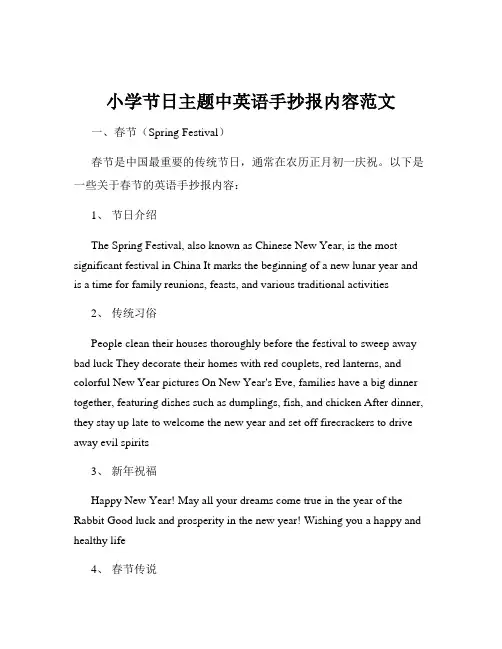
小学节日主题中英语手抄报内容范文一、春节(Spring Festival)春节是中国最重要的传统节日,通常在农历正月初一庆祝。
以下是一些关于春节的英语手抄报内容:1、节日介绍The Spring Festival, also known as Chinese New Year, is the most significant festival in China It marks the beginning of a new lunar year and is a time for family reunions, feasts, and various traditional activities2、传统习俗People clean their houses thoroughly before the festival to sweep away bad luck They decorate their homes with red couplets, red lanterns, and colorful New Year pictures On New Year's Eve, families have a big dinner together, featuring dishes such as dumplings, fish, and chicken After dinner, they stay up late to welcome the new year and set off firecrackers to drive away evil spirits3、新年祝福Happy New Year! May all your dreams come true in the year of the Rabbit Good luck and prosperity in the new year! Wishing you a happy and healthy life4、春节传说There is a legend about a monster called "Nian" who would come out to harm people on New Year's Eve But people found that Nian was afraid of the color red and loud noises So they started to use red decorations and set off firecrackers to scare Nian away二、元宵节(Lantern Festival)The Lantern Festival falls on the 15th day of the first lunar month It is a celebration of the end of the Spring Festival1、节日特色People enjoy viewing various kinds of lanterns in the streets and parks The lanterns come in different shapes and colors, such as animals, flowers, and figures from Chinese myths and legends2、传统美食Sweet dumplings are a popular food during the Lantern Festival They are made of glutinous rice flour and filled with sweet fillings like sesame, peanut, or red bean paste3、活动There are also lion and dragon dances, riddle guessing games, and fireworks displays Riddle guessing is very interesting People write riddles on lanterns and others try to solve them4、意义The Lantern Festival symbolizes family unity and happiness It is a time for people to have fun and enjoy the last moments of the Spring Festival三、清明节(TombSweeping Day)TombSweeping Day, also known as Qingming Festival, usually falls around April 4th or 5th in the solar calendar1、节日目的It is a day for people to remember and honor their ancestors by visiting their graves, cleaning the tombs, and offering sacrifices2、传统活动People also fly kites, plant trees, and enjoy the spring scenery Some families have a picnic near the graves to spend time together3、诗句"清明时节雨纷纷,路上行人欲断魂。
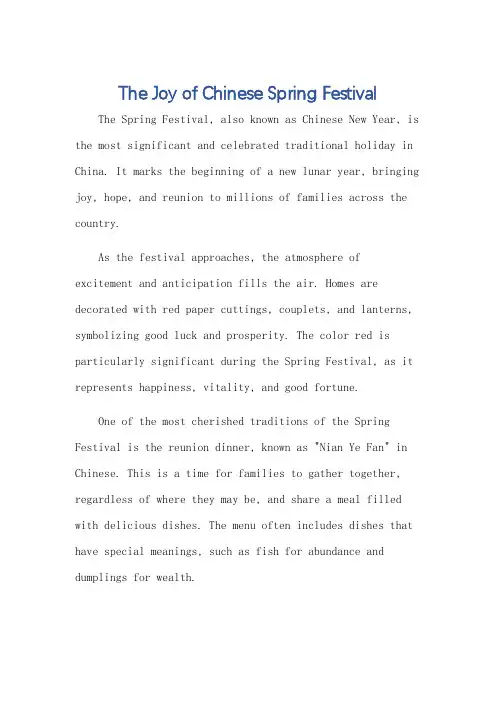
The Joy of Chinese Spring FestivalThe Spring Festival, also known as Chinese New Year, is the most significant and celebrated traditional holiday in China. It marks the beginning of a new lunar year, bringing joy, hope, and reunion to millions of families across the country.As the festival approaches, the atmosphere of excitement and anticipation fills the air. Homes are decorated with red paper cuttings, couplets, and lanterns, symbolizing good luck and prosperity. The color red is particularly significant during the Spring Festival, as it represents happiness, vitality, and good fortune.One of the most cherished traditions of the Spring Festival is the reunion dinner, known as "Nian Ye Fan" in Chinese. This is a time for families to gather together, regardless of where they may be, and share a meal filled with delicious dishes. The menu often includes dishes that have special meanings, such as fish for abundance and dumplings for wealth.Another highlight of the festival is the setting off of fireworks and firecrackers. The bright lights and loudbangs are believed to scare away evil spirits and bringgood luck for the coming year. Children especially lovethis part of the celebration, as they run around with sparkling fireworks, laughing and screaming with excitement. The Spring Festival also features a variety of cultural performances and activities. Lion dances and dragon dances are common, performed by teams of dancers in vibrant costumes to entertain and bring good luck to the audience. There are also temple fairs and flower markets, wherepeople can buy traditional goods, snacks, and flowers to decorate their homes.One cannot forget the red envelopes, or "hongbao,"which are given to children and unmarried adults as asymbol of good luck and blessing. These envelopes areusually filled with money, and receiving them is one of the most exciting parts of the festival for many young people.The celebrations last for several days, with each day bringing its own special traditions and activities. On the first day of the new year, families visit relatives andfriends, exchanging greetings and wishes for a happy and prosperous year ahead.The Spring Festival is not just a time for celebration and merriment; it is also a time for reflection and renewal. It is a reminder of the importance of family, unity, andthe spirit of giving and sharing. As the new year dawns, people make resolutions to be better, to work harder, andto cherish the moments they share with loved ones.In conclusion, the Spring Festival is a vibrant and joyful celebration that brings people together and embodies the essence of Chinese culture. It is a time for reunion, celebration, and the pursuit of happiness and prosperity.As the world becomes more interconnected, it is wonderfulto see the Spring Festival being celebrated by people ofall backgrounds, sharing in the joy and spirit of this remarkable holiday.**中国春节的欢乐**春节,又称中国新年,是中国最重要的传统节日,也是全国范围内庆祝最盛大的节日。

有关中国传统节日的英语手抄报Chinese traditional festivals are an integral part of the country's rich cultural heritage. They are colorful, lively, and filled with centuries-old traditions and customs that have been passed down from generation to generation. These festivals not only provide an opportunity for family members to come together and celebrate, but they also serve as a platform for showcasing Chinese history, values, and beliefs. In this handout, we will explore some of the most significant Chinese traditional festivals and what makes them special.1. Spring Festival (Chinese New Year):The Spring Festival, also known as Chinese New Year, is perhaps the most important and widely celebrated festival in China. It marks the beginning of the lunar new year and is associated with wealth, health, and good fortune. The festival is characterized by several customs, such as cleaning and decorating homes, exchanging red envelopes filled with money, setting off fireworks, and enjoying festive foods like dumplings and glutinous rice cakes.2. Lantern Festival:The Lantern Festival is celebrated on the 15th day of the lunar new year, marking the end of the Spring Festival celebrations. It is named after the traditional practice of lighting and displaying lanterns. People gather together to enjoy lantern displays, solve riddles written on lanterns, perform lion dances, and eat sweet glutinous rice balls called tangyuan. The festival signifies the coming of spring and the reunion of family members.3. Dragon Boat Festival:The Dragon Boat Festival, also known as Duanwu Festival, takes place on the 5th day of the 5th month of the lunar calendar. The festival commemorates the death of the ancient poet and statesman Qu Yuan and is celebrated with dragon boat races, where teams paddle in sync to the beat of drums. Traditional food includes zongzi, pyramid-shaped glutinous rice wrapped in bamboo leaves, which symbolizes respect for Qu Yuan. People also hang up pouches of herbs to ward off evil spirits.4. Mid-Autumn Festival:The Mid-Autumn Festival, also known as the Moon Festival, is celebrated on the 15th day of the 8th month of the lunar calendar. It is a time for family reunions and thanksgiving for the harvest. The festival is marked by the consumption of mooncakes, round pastries filled with various sweet or savory fillings, representing the full moon. Families also gather to appreciate the full moon, light lanterns, and take part in activities such as lion dances and offering sacrifices to the moon goddess Chang'e.5. Qingming Festival:The Qingming Festival, also known as Tomb-Sweeping Day, is a time for Chinese people to visit the graves of their ancestors and pay their respects. It falls on April 4th or 5th each year and signifies the start of spring. Families clean the burial sites, offer food and paper money to the deceased, and burn incense. It is also a popular time for outdoor activities like flying kites and enjoying the beautiful blooming spring scenery.6. Double Seventh Festival (Chinese Valentine's Day):The Double Seventh Festival, also known as Qixi Festival or Chinese Valentine's Day, is celebrated on the 7th day of the 7th month of the lunar calendar. The festival is based on the Chinese folklore tale of the Cowherd and Weaver Girl, who can only meet once a year on this day when a bridge of magpies forms in the sky. Traditions include making and wearing bracelets, weaving colorful silk threads into intricate patterns, and releasing paper lanterns into the night sky.These are just a few examples of the many Chinese traditional festivals that are celebrated throughout the year. Each festival has its unique customs, symbolic meanings, and regional variations. They not only provide an opportunity for celebration and enjoyment but also serve as a way to connect with Chinese history, culture, and values. By participating in these festivals, we can experience firsthand the vibrant and diverse traditions that have shaped Chinese society for centuries.。
中国传统节日英语手抄报模板Traditional Chinese Festival: Chinese Traditional FestivalIntroduction:- In China, there are many traditional festivals that have been celebrated for centuries.- These festivals are an important part of Chinese culture and are a time for family reunions and joyous celebrations.1. Spring Festival (Chinese New Year):- Also known as the Lunar New Year, it is the most important festival in China.- Celebrated on the first day of the lunar calendar, usually in January or February.- Activities include family gatherings, firework displays, lion and dragon dances, and exchanging red envelopes with money.2. Lantern Festival:- Celebrated on the 15th day of the Lunar New Year, marking the end of the Chinese New Year celebrations.- Lanterns of various shapes and sizes are displayed and lit up at night.- There are lantern parades, lantern riddles, and a special sweet glutinous rice ball called "Tangyuan" is eaten.3. Dragon Boat Festival:- Celebrated on the 5th day of the 5th month of the lunar calendar, usually in June.- The festival commemorates the death of a poet and statesman named Qu Yuan.- Dragon boat races, where teams paddle in long narrow boats, are held to honor him.4. Mid-Autumn Festival:- Celebrated on the 15th day of the 8th month of the lunar calendar, usually in September or October. - People gather to appreciate the full moon while eating mooncakes, a traditional pastry filled with sweet or savory ingredients.- It is also a time for family reunions and expressing gratitude for the bountiful harvest. Conclusion:- Chinese traditional festivals are not only a time for celebration but also an opportunity to preserve and pass on Chinese cultural heritage.- These festivals bring warmth, happiness, and a sense of unity among the Chinese people.。
英语中秋国庆手抄报英文版Mid-Autumn Festival and National Day Handwritten ReportTitle: Celebrating Chinese Tradition and National PrideIntroduction:The Mid-Autumn Festival and National Day are two significant holidays in China, representing both cultural heritage and national pride. Let's explore the essence of these festivals and their importance in Chinese society.Section 1: Mid-Autumn Festival-The Mid-Autumn Festival is traditionally celebrated on the 15th day of the eighth lunar month.-It is a time for families to come together, appreciate the full moon, and enjoy mooncakes.-Mooncakes, with various flavors and fillings, symbolize unity and family reunion.-Folklore and myths surrounding the Moon Goddess Chang'e and the Jade Rabbit add to the festival's charm.Section 2: National Day-National Day, also known as the Chinese Independence Day, is celebrated on October 1st.-It commemorates the founding of the People's Republic of China in 1949.-Various activities like parades, flag-raising ceremonies, and fireworks take place nationwide.-National Day reflects the Chinese people's patriotism and highlights their achievements and progress. Section 3: Cultural Significance-Both festivals promote Chinese cultural heritage and reinforce national identity.-The Mid-Autumn Festival showcases Chinese values of filial piety, togetherness, and gratitude.-National Day emphasizes the unity, resilience, and pride of the Chinese people.-These festivals provide opportunities for people to embrace their roots and strengthen their cultural bonds.Conclusion:The Mid-Autumn Festival and National Day play significant roles in celebrating Chinese tradition and national pride. They remind us of our cultural heritage, family values, and the great achievements of our nation. Let's cherish these holidays and pass down their significance to future generations.。
英语四年级节日手抄报内容英语四年级节日手抄报内容:标题:Festivals around the world1. Annual Festivals:- Chinese New Year: Chinese New Year, also known as Spring Festival, is the most important holiday in China. It is celebrated with dragon dances, fireworks, and family gatherings.- Thanksgiving: Thanksgiving is a holiday celebrated in the United States and Canada. It is a time for people to give thanks for a good harvest and blessings of the past year. Families often gather for a big meal with a turkey as the centerpiece.- Diwali: Diwali is a Hindu festival of lights celebrated in India and other countries. People light oil lamps, decorate their houses, and exchange gifts during this joyful festival.2. Cultural Festivals:- Easter: Easter is a Christian holiday celebrated in many parts of the world. It commemorates the resurrection of Jesus Christ. Families often participate in egg hunts and church services during Easter. - Halloween: Halloween is a holiday celebrated on October 31st. It originated from an ancient Celtic festival called Samhain. People dress up in costumes, carve pumpkins, and go trick-or-treating.- St. Patrick's Day: St. Patrick's Day is a cultural and religious holiday celebrated on March 17th. It is associated with Irish culture and the patron saint of Ireland, St. Patrick. People wear green, decorate with shamrocks, and attend parades.3. Festivals from Different Countries:- Hanami: Hanami is a Japanese tradition of flower viewing, particularly cherry blossoms. It is a time for people to appreciate the beauty of nature and spend time with family and friends.- La Tomatina: La Tomatina is a festival held in Spain where participants throw tomatoes at each other. It is a fun and messy event that takes place in the town of Buñol.- Carnival: Carnival is a festive season celebrated in many countries around the world. It usually involves parades, costumes, and street parties. The most famous carnival is held in Rio de Janeiro, Brazil.4. Festivals with Global Significance:- Earth Day: Earth Day is celebrated on April 22nd to promote environmental protection and sustainability. People participate in various activities such as tree planting and cleaning up the environment.- Christmas: Christmas is a Christian holiday celebrated on December 25th. It commemorates the birth of Jesus Christ. People decorate Christmas trees, exchange gifts, and spend time with loved ones. Conclusion: Festivals provide opportunities for people to come together, celebrate their culture, and create lasting memories. They are also a way to learn about different traditions and customs from around the world.。
手抄报英语节日教程English Festival TutorialMaterials needed:- Paper or cardstock- Colored pens or markers- Glue or adhesive tape- Scissors- Decorative materials (stickers, glitter, ribbons, etc.)1. Choose a festival or holiday that you want to create a tutorial for, such as Christmas, Thanksgiving, Halloween, or New Year's Day.2. Decide on the format of your tutorial, whether it will be a step-by-step guide or an informative poster.3. Divide the information into sections. For example:- Introduction: Briefly explain the festival and its significance.- Traditions: Describe the common customs and traditions associated with the festival.- Food: List typical dishes or treats that are enjoyed during the festival.- Decorations: Discuss how people decorate their homes or surroundings for the festival.- Activities: Mention any special activities or games that people participate in during the festival.- Conclusion: Summarize the festival and add any personal thoughts or experiences you may have.4. Take a piece of paper or cardstock and write the title of yourtutorial at the top. For example, "Christmas Festival Tutorial."5. Draw or print relevant images related to the festival, such as Santa Claus, a Thanksgiving turkey, or a Chinese New Year dragon.6. Begin with the introduction section. Write a brief but informative paragraph about the festival. Use colored pens or markers to make it visually engaging.7. Move on to the traditions section. Write a few key points or steps, along with illustrations if desired, to explain the common customs associated with the festival.8. Include a section about the food typically enjoyed during the festival. List popular dishes or treats, along with any unique recipes or ingredients.9. Provide details about the decorations used for the festival. Describe the colors, ornaments, and symbols associated with the festival.10. Add a section about special activities or games that are played during the festival. Describe how they are played and their significance.11. Finally, conclude your tutorial by summarizing the festival and sharing any personal thoughts or experiences you may have had.12. Decorate the tutorial with stickers, glitter, ribbons, or any otherdecorative materials you may have on hand. Use your creativity to make it visually appealing.13. Trim the edges of the paper or cardstock if desired, and make sure all the sections flow smoothly and are easy to read.14. Once you are satisfied with your tutorial, use glue or adhesive tape to stick it onto a cardstock or construction paper to create a more sturdy and presentable handout.15. Share your tutorial with others by either presenting it in class or displaying it on a bulletin board.Remember to have fun while creating the tutorial and let your creativity shine through!。
一年级24节气小报英语模板The 24 Solar Terms are an ancient Chinese system of dividing the year into 24 periods based on the sun's position. These terms have been used for centuries to guide agricultural activities and to understand the changing of the seasons. As an educational tool, the 24 Solar Terms can be a fascinating and engaging way to teach young students about the natural world and the cycles of nature.In this essay, we will explore a template for a primary school 24 Solar Terms project, focusing on how to present this information in an engaging and educational way for young learners.The first step in creating a 24 Solar Terms project is to provide an overview of the system. This can be done through a brief introduction that explains what the 24 Solar Terms are, how they are determined, and why they are important. This introduction should be written in simple, easy-to-understand language that is appropriate for primary school students.Next, the project should focus on each of the 24 Solar Termsindividually. For each term, the project should include the following information:1. The name of the Solar Term: This should be presented in both English and the original Chinese.2. The date of the Solar Term: This should be given in both the Gregorian calendar and the traditional Chinese calendar.3. A brief description of the Solar Term: This should explain what the term represents and how it relates to the changing of the seasons.4. Seasonal characteristics: This should describe the typical weather patterns, plant and animal life, and agricultural activities associated with the Solar Term.5. Cultural traditions: Many of the Solar Terms are associated with traditional festivals, rituals, or customs. These should be briefly described.6. Illustrations or photographs: Visual aids can help students better understand the Solar Terms and the changes they represent.To make the project more engaging for young learners, the template should also include interactive elements. For example, the project could include a matching game where students match the Solar Term to its corresponding description or a coloring activity where students can create their own illustrations of the Solar Terms.Additionally, the project should encourage students to explore theconnections between the Solar Terms and their own lives. This could be done through activities such as a nature journal where students observe and record the changes in their local environment over the course of the year, or a cooking activity where students prepare traditional dishes associated with a particular Solar Term.Throughout the project, it is important to use language that is appropriate for primary school students. This means using simple, straightforward language, avoiding complex vocabulary, and explaining any unfamiliar concepts in a clear and accessible way.In conclusion, a primary school 24 Solar Terms project can be a powerful educational tool that helps young students learn about the natural world and the cycles of nature. By providing a comprehensive overview of the Solar Terms, engaging students with interactive activities, and encouraging them to explore the connections between the Solar Terms and their own lives, this project can inspire a deeper appreciation for the natural world and a greater understanding of the changing seasons.。
英语关于中国节日的手抄报[图片]: Chinese Festivals[标题]: Chinese Festivals - A Celebration of Traditions and Culture[大标题]: IntroductionChina, a country rich in history and tradition, is home to a variety of unique and vibrant festivals. These celebrations are an integral part of Chinese culture, showcasing the values, beliefs, and customs passed down from generation to generation. In this handout, we explore some of the most significant festivals in China and their significance.[子标题1]: Chinese New Year (Spring Festival)Chinese New Year, also known as Spring Festival, is the most important and widely celebrated festival in China. It marks the beginning of the lunar calendar and is usually held between January and February. The festival is filled with vibrant decorations, firework displays, dragon dances, and the exchange of red envelopes filled with money. Families come together to enjoy festive meals, pay respect to ancestors, and wish for good fortune and prosperity in the upcoming year.[子标题2]: Lantern FestivalLantern Festival takes place on the fifteenth day of the first lunarmonth, marking the end of the Chinese New Year celebrations. The highlight of this festival is the lighting of colorful lanterns, which symbolize good luck and prosperity. Lanterns of various shapes and sizes are hung in public places, such as parks and temples, creating a mesmerizing display of lights. People also participate in lantern riddle guessing games and enjoy traditional performances, including lion dances and stilt-walking.[子标题3]: Mid-Autumn FestivalMid-Autumn Festival, also known as the Moon Festival, is held on the fifteenth day of the eighth lunar month. It is a time for families to gather and appreciate the beauty of the full moon while enjoying mooncakes, a traditional delicacy made from lotus seed paste and duck eggs. Lanterns are also an essential part of this festival, with children parading around with colorful lanterns in various shapes. The festival celebrates the harvest season and symbolizes unity and good fortune.[子标题4]: Dragon Boat FestivalDragon Boat Festival, also known as Duanwu Festival, is celebrated on the fifth day of the fifth lunar month. This festival commemorates the death of the famous poet and statesman Qu Yuan. The highlight of the festival is the exciting dragon boat races, where teams paddle vigorously in long, narrow boats to the rhythm of drums. Additionally, people eat zongzi, sticky rice wrapped in bamboo leaves, to remember the rice offerings made to Qu Yuan's spirit.[结尾段落]: ConclusionChinese festivals are more than mere celebrations; they are a reflection of the rich history, culture, and traditions that define the Chinese people. These festivals foster a sense of unity, family bonds, and respect for ancestors. They provide a unique opportunity to experience Chinese customs, taste traditional delicacies, and witness breathtaking performances. By participating in these festivals, one can truly immerse themselves in the vibrant tapestry of Chinese culture.Note: Please note that the above handout is for reference purposes only. It may be necessary to add or modify the content for presentation purposes.。